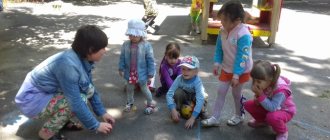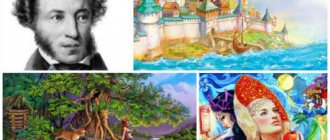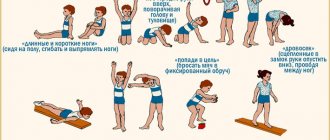Card index of experiments and experimental games in the preparatory group
Svetlana Dozhirova
Card index of experiments and experimental games in the preparatory group
Preparatory group
1. Why does everything sound?
Goal: to lead children to understand the causes of sound: vibration of an object.
Materials: tambourine, glass glass, newspaper, balalaika or guitar, wooden ruler, metallophone.
Description.
• Game “What does it sound like?”
- the teacher offers the children
close their eyes, and he makes sounds using the means known to them
items. Children guess what it sounds like. Why do we hear these sounds? What is sound? Children are asked to imitate with their voice: how does a mosquito ring? (Z-z-z.)
How does a fly buzz?
(Zh-zh.)
How does a bumblebee buzz?
(Uh-oh.)
Then each child is asked to touch the string of the instrument, listen to its sound and then touch the string with his palm to stop the sound. What happened? Why did the sound stop? The sound continues as long as the string vibrates. When she stops, the sound also disappears.
Does a wooden ruler have a voice? Children are asked to make a sound using a ruler. We press one end of the ruler to the table, and clap the free end with our palm. What happens to the ruler? (Trembles, hesitates)
How to stop the sound?
(Stop the vibration of the ruler with your hand)
Extract the sound from the glass glass using a stick, stop. When does sound arise? The sound occurs when air moves back and forth very quickly. This is called oscillation. Why does everything sound? How else can you name objects that will sound?
1. Clear water
Purpose: to identify the properties of water (transparent, flows odorless, has weight)
.
Materials: two opaque jars (one filled with water, a glass jar with a wide neck, spoons, small ladles, a bowl of water, a tray, object pictures
Description.
• Droplet came to visit. Who is Droplet? What is she with?
likes to play?
On the table, two opaque jars are closed with lids, one of them is filled with water. Children are asked to guess what is in these jars without opening them. Are they the same weight? Which one is easier? Which one is heavier? Why is it heavier? We open the jars: one is empty - therefore light, the other is filled with water. How did you guess that it was water? What color is it? What does the water smell like?
An adult invites the children to fill a glass jar with water. To do this, they are offered a variety of containers to choose from. What is more convenient to pour? How to prevent water from spilling on the table? What are we doing? (Pour, pour water.)
What does water do?
(It pours.)
Let's listen to how it pours. What sound do we hear?
• When the jar is filled with water, children are invited to play the game “Recognize and Name”
(looking at
pictures through the jar ) .
What did you see? the picture
so clear • What kind of water? (Transparent.)
What have we learned about water?
3. Making soap bubbles.
Goal: to introduce children to the method of making soap bubbles and the properties of liquid soap: it can stretch and form a film.
Materials: liquid soap, pieces of soap, a loop with a wire handle, cups, water, spoons, trays.
Description. Misha the bear brings the picture “Girl playing with soap bubbles”
.
Children look at the picture .
What is the girl doing? How are soap bubbles made? Can we make them? What is needed for this? Children try to make soap bubbles from a bar of soap and water by mixing. Observe what happens: lower the loop into the liquid, take it out, blow into the loop.
Take another glass, mix liquid soap with water (1 spoon of water and 3 spoons of liquid soap)
. Lower the loop into the mixture. What do we see when we take out the loop? Slowly we blow into the loop. What's happening? How did the soap bubble come about? Why did the soap bubble come only from liquid soap? Liquid soap can stretch into a very thin film. She remains in the loop. We blow out air, the film envelops it, and it turns out to be a bubble.
• Game, “What shape are the bubbles, which flies further, higher?”
Children blow bubbles and tell what the resulting bubble looks like, what shape it is, what colors can be seen on its surface.
4. Air is everywhere
Objectives: detect air in the surrounding space and identify its property - invisibility.
Materials: balloons, a bowl of water, an empty plastic bottle, sheets of paper.
Description. Little Chick Curious asks the children a riddle about air.
Passes through the nose into the chest
And he's on his way back.
He's invisible and yet
We cannot live without him.
(Air)
What do we inhale through our nose? What is air? What is it for? Can we see it? Where is the air? How do you know if there is air around?
• Game exercise “Feel the air”
— the children wave a sheet of paper near their faces. What do we feel? We don't see air, but it surrounds us everywhere.
• Do you think there is air in the empty bottle? How can we check this? An empty transparent bottle is lowered into a basin of water until it begins to fill. What's happening? Why do bubbles come out of the neck? This water displaces the air from the bottle. Most objects that appear empty are actually filled with air.
Name the objects that we fill with air. Children inflate balloons. What do we fill the balloons with? Air fills every space, so nothing is empty.
5. Light is everywhere
Objectives: show the meaning of light, explain that light sources can be natural (sun, moon, fire, artificial - made by people (lamp, flashlight, candle)
.
Materials: illustrations of events occurring at different times of the day; pictures with images of light sources; several objects that do not provide light; flashlight, candle, table lamp, chest with a slot.
Description. Grandfather Know invites children to determine whether it is dark or light now and explain their answer. What's shining now? (Sun.)
What else can illuminate objects when it is dark in nature?
(Moon, fire.)
Invites children to find out what is in
the “magic chest” (there is a flashlight inside)
.
The children look through the slot and note that it is dark and nothing can be seen. How can I make the box lighter? (Open the chest, then light will come in and illuminate everything inside it.)
Open the chest, light will come in, and everyone will see a flashlight.
And if we don’t open the chest, how can we make it light? He lights a flashlight and puts it in the chest. Children look at the light through the slot.
• Game “Light can be different”
- Grandfather Znay invites children to sort
the pictures into two groups : light in nature, artificial light - made by people. What shines brighter - a candle, a flashlight, a table lamp? pictures depicting these objects in the same sequence What shines brighter - the sun, the moon, a fire? Compare the pictures and sort them according to the brightness of the light (from the brightest)
.
6. Light and shadow
Objectives: to introduce the formation of shadows from objects, to establish the similarity between a shadow and an object, to create images using shadows.
Materials: equipment for shadow theater, lantern.
Description. Misha the bear cub arrives with a flashlight. The teacher asks him: “What do you have? What do you need a flashlight for?
Misha offers to play with him. The lights turn off and the room goes dark. Children, with the help of a teacher, shine a flashlight and look at different objects. Why do we see everything clearly when a flashlight is shining?
Misha places his paw in front of the flashlight. What do we see on the wall? (Shadow.)
He suggests doing the same for the children.
Why is a shadow formed? (The hand interferes with the light and does not allow it to reach the wall.)
The teacher suggests using the hand to show the shadow of a bunny or dog. Children repeat. Misha gives the children a gift.
• Game “Shadow Theater”
. The teacher takes out a shadow theater from the box. Children examine equipment for a shadow theater. What is unusual about this theater? Why are all the figures black? What is a flashlight for? Why is this theater called shadow theater? How is a shadow formed? Children, together with the bear cub Misha, look at animal figures and show their shadows.
• Showing a familiar fairy tale, for example “Kolobok”
, or any other.
7. Frozen water
Task: to reveal that ice is a solid substance, floats, melts, and consists of water.
Materials: pieces of ice, cold water, plates, a picture of an iceberg.
Description. In front of the children is a bowl of water. They discuss what kind of water it is, what shape it is. Water changes shape because it is liquid.
Can water be solid? What happens to water if it is cooled too much? (The water will turn into ice.)
Examine the pieces of ice. How is ice different from water? Can ice be poured like water? The children are trying to do this. What shape is the ice? Ice retains its shape. Anything that retains its shape, like ice, is called a solid.
• Does ice float? The teacher puts a piece of ice in a bowl and
children are watching. How much ice floats? (Top.)
Huge blocks of ice float in the cold seas. They are called icebergs (show picture )
. Above the surface
Only the tip of the iceberg is visible. And if the captain of the ship
does not notice and stumbles upon the underwater part of the iceberg, then
the ship may sink.
The teacher draws the children's attention to the ice that was in the plate. What happened? Why did the ice melt? (The room is warm.)
What has the ice turned into? What is ice made of?
• "Playing with ice cubes"
- free activities of children:
they select plates, examine and observe what
happens with ice floes.
8. Multi-colored balls
Task: to obtain new shades by mixing primary colors: orange, green, purple, blue.
Materials: palette, gouache paints: blue, red, white, yellow; rags, water in glasses, sheets of paper with a contour image (4-5 balls for each child, flannelgraph, models - colored circles and half circles (corresponding to the colors of the paints, worksheet.
Description. The bunny brings the children sheets with pictures of balls and asks them to help him color them. Let's find out from him what color balls he likes best. What if we don’t have blue, orange, green and purple paints? How can we make them?
• Children and the bunny mix two colors each. If the desired color is obtained, the mixing method is fixed using models (circles)
. Then the children use the resulting paint to paint the ball. So children experiment until they get all the necessary colors.
Conclusion: by mixing red and yellow paint, you can get orange; blue with yellow - green, red with blue - purple, blue with white - blue. The results of the experiment are recorded in the worksheet (Fig. 5)
.
9. Sand Country
Tasks: highlight the properties of sand: flowability, friability, you can sculpt from wet sand; introduce the method of making a picture from sand.
Materials: sand, water, magnifying glasses, sheets of thick colored paper, glue sticks.
Description: Grandfather Know invites children to look at the sand: what color, try it by touch (loose, dry)
.
What is sand made of? What do grains of sand look like? How can we look at grains of sand? (Using a magnifying glass.)
The grains of sand are small, translucent, round, and do not stick to each other. Is it possible to sculpt from sand? Why can't we make anything out of dry sand? Let's try to mold it from wet. How can you play with dry sand? Is it possible to paint with dry sand?
• On thick paper with a glue stick, children are asked to draw something (or trace a finished drawing,
and then pour sand onto the glue. Shake off excess sand
and see what happened.
Everyone looks at the children's drawings together.
10. Ringing water
Task: show children that the amount of water in a glass affects the sound made.
Materials: a tray on which there are various glasses, water in a bowl, ladles, “fishing rods”
with a thread with a plastic ball attached to the end.
Description. There are two glasses filled with water in front of the children. How to make glasses sound? All the children’s options are checked (knock with a finger, objects that the children offer)
. How to make the sound louder?
• Available in a stick with a ball at the end. Everyone listens to the clinking of glasses of water. Are we hearing the same sounds? Then grandfather Znay pours and adds water to the glasses. What affects the ringing? (The amount of water affects the ringing, the sounds are different.)
• Children try to compose a melody.


